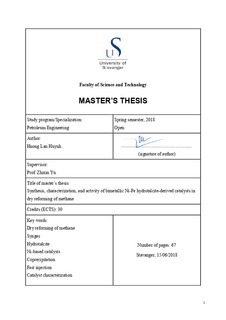| dc.description.abstract | The extensive amount of carbon dioxide (CO2) emitted into atmosphere is arguably considered to be the main reason for global climate change due to the greenhouse effect. For decades, considerable efforts have been devoted to address this issue. Amongst the proposed solutions, dry reforming of methane (DRM) using CO2 as feedstock for syngas production emerges as a promising alternative. DRM reaction utilizes two major greenhouse gases, methane (CH4) and CO2, and converts them into valuable syngas with hydrogen and carbon monoxide product ratio (H2/CO ratio) close to unity, a desirable intermediate for a wide range of chemicals synthesis. Heterogeneous catalysts are commonly used for the DRM reaction; however, the development of active and stable catalysts is still challenging. The noble metals (e.g. Rh, Pt, Ir, Pd and Ru) exhibit excellent catalytic activity and stability for DRM reactions, but the high cost and limited availability prevent their industrial application. Transition metals (e.g. Ni, Co) have good catalytic performance but suffer from fast deactivation due to carbon deposition and metal sintering. Recently, Ni-based hydrotalcite-derived (HT) materials have been proposed as promising or DRM reaction. In this study, a series of bimetallic Ni-Fe catalysts supported on MgAl2O4 were prepared via HT precursors. The Ni loading was kept constant at 20 wt.% for all the catalysts while Fe content was varied by different Fe/Ni molar ratios. Two different coprecipitation methods were studied, namely conventional method (low supersaturation) and fast injection method (high supersaturation). The characteristics of catalysts were investigated by X-ray diffraction, nitrogen adsorption-desorption, hydrogen chemisorption, temperature programmed reduction and temperature programmed desorption. The HT-like materials were successfully synthesized with high crystallinity and porosity; small Ni-Fe alloy particles were highly dispersed and homogeneously distributed after the calcination of the precursors. The addition of Fe improved the reducibility and basicity of the catalyst. The advantage of fast injection method was demonstrated by that the catalyst possessing higher surface area, narrower size distribution, enhanced reducibility, and higher basicity. The catalytic performance towards DRM reaction was studied in a fixed-bed reactor at 700 oC and atmospheric pressure. An equimolar CH4/CO2 feed at high gas hourly space velocity (GHSV) of 240,000 mL.g-1.h-1 was used. Ni-based catalyst with a small addition of Fe exhibited better performance than monometallic catalysts. The optimal composition was found at an Fe/Ni molar ratio of 0.1. A higher reduction temperature was also tested. Interestingly, a high and stable conversion of CH4 and CO2 during 18 hours of time on stream was achieved by the catalyst synthesized by fast injection method. The synthesis of small and uniform Ni-Fe alloy particles could be an effective approach to improve catalytic activity and stability against carbon formation and sintering for DRM reaction toward commercialization. | nb_NO |
